Mostrar el registro sencillo del ítem
dc.contributor.author
Bedano, José Camilo

dc.contributor.author
Ruf, Andrea
dc.date.available
2021-05-03T15:03:20Z
dc.date.issued
2010-05
dc.identifier.citation
Bedano, José Camilo; Ruf, Andrea; Sensitivity of different taxonomic levels of soil Gamasina to land use and anthropogenic disturbances; Wiley Blackwell Publishing, Inc; Agricultural And Forest Entomology; 12; 2; 5-2010; 203-212
dc.identifier.issn
1461-9555
dc.identifier.uri
http://hdl.handle.net/11336/131253
dc.description.abstract
The effect of taxonomic level on the sensitivity of bioindicators has been widely investigated in aquatic ecosystems and, to a lesser extent, in terrestrial ecosystems. However, no studies have been conducted on the sensitivity of the different taxonomic levels of soil mites, especially Gamasina, to human activities. The present study aimed to assess the sensitivity of different taxonomic levels of soil Gamasina mites to anthropogenic disturbances in Europe and Argentina. We arranged the data from previous projects in a hierarchical system and conducted a study to identify the critical taxonomical levels that had the highest discriminative potential between sites (Europe and Argentina) or management types (forests, grasslands, fallows, succession, recultivation and agricultural sites). For the Gamasina community, geographical location was by far more important than the influence of any land use type. The analysis including only the European sites demonstrated that communities belonging to sites subjected to different land uses were also significantly different. The species data set provided a clearer separation of sites according to both the geographical and the land-use gradients than the genus and family data sets. The genus and, to a lesser extent, the family approach may be sufficient to elucidate the influence of great geographical differences and also of certain land uses (e.g. grasslands from the forests and arable sites).5 Species presence/absence data provided valuable information in our analyses, although the use of quantitative data yielded a clearer separation of sites.
dc.format
application/pdf
dc.language.iso
eng
dc.publisher
Wiley Blackwell Publishing, Inc

dc.rights
info:eu-repo/semantics/openAccess
dc.rights.uri
https://creativecommons.org/licenses/by-nc-sa/2.5/ar/
dc.subject
GAMASINA
dc.subject
MITES
dc.subject
PRESENCE/ABSENCE DATA
dc.subject
TAXONOMIC RESOLUTION
dc.subject.classification
Ecología

dc.subject.classification
Ciencias Biológicas

dc.subject.classification
CIENCIAS NATURALES Y EXACTAS

dc.title
Sensitivity of different taxonomic levels of soil Gamasina to land use and anthropogenic disturbances
dc.type
info:eu-repo/semantics/article
dc.type
info:ar-repo/semantics/artículo
dc.type
info:eu-repo/semantics/publishedVersion
dc.date.updated
2021-04-09T16:19:17Z
dc.identifier.eissn
1461-9563
dc.journal.volume
12
dc.journal.number
2
dc.journal.pagination
203-212
dc.journal.pais
Reino Unido

dc.journal.ciudad
Londres
dc.description.fil
Fil: Bedano, José Camilo. Universidad Nacional de Río Cuarto. Facultad de Ciencias Exactas, Fisicoquímicas y Naturales. Departamento de Geología; Argentina. Consejo Nacional de Investigaciones Científicas y Técnicas. Centro Científico Tecnológico Conicet - Córdoba; Argentina
dc.description.fil
Fil: Ruf, Andrea. Universitat Bremen; Alemania
dc.journal.title
Agricultural And Forest Entomology

dc.relation.alternativeid
info:eu-repo/semantics/altIdentifier/doi/http://dx.doi.org/10.1111/j.1461-9563.2009.00470.x
dc.relation.alternativeid
info:eu-repo/semantics/altIdentifier/url/https://onlinelibrary.wiley.com/doi/full/10.1111/j.1461-9563.2009.00470.x
Archivos asociados
